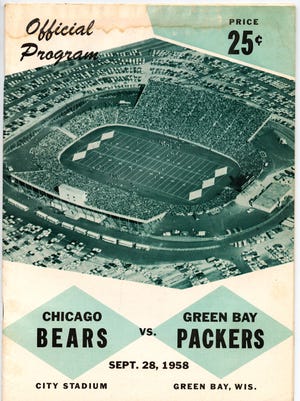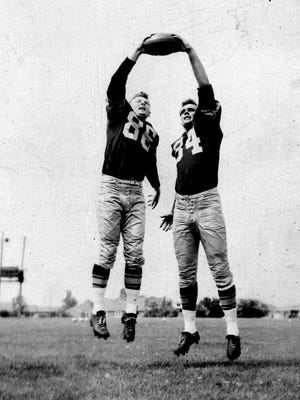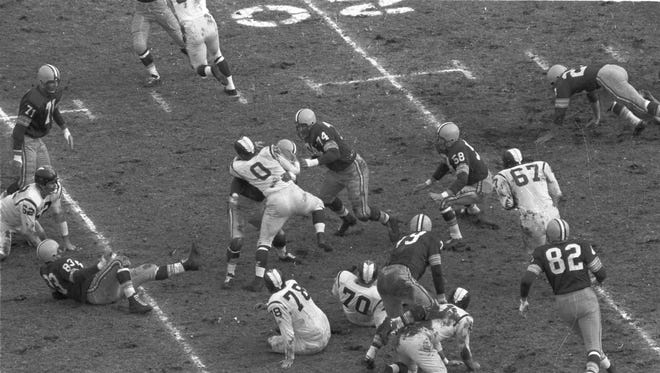How To Draw Green Bay Packers

GREEN BAY – The proposal, so conceived, was to requite the Green Bay Packers a beating heart. Sixty years ago, they were no longer America'southward darling. On their deathbed, the Packers were barely the pride of Green Bay.
By 1954, County Stadium in Milwaukee was a year sometime. Its 45,000 chapters enticed the Packers to permanently motion two hours south. In a league in which most professional person football franchises played in big-league baseball parks, Green Bay'south rickety high school field was no longer acceptable.
The city needed a new stadium. Its future with the Packers depended on it.
From that crossroads, Lambeau Field was born Sept. 29, 1957 when the Packers hosted the Chicago Bears. The new City Stadium wouldn't be renamed later on franchise founder Curly Lambeau for eight years. It seated 32,500 at capacity, a xxx percent increment from old City Stadium. Nationally, it was considered the outset venue built exclusively for professional football.
Every bit Lambeau Field expanded over the years, then did its significance. It'due south a cathedral not only for Packers fans, but all the NFL. It's an almanac family reunion, generations bonding nether cream cheese hats. It's putting your baby'due south name on a waiting list. It'southward passing flavor tickets through your will.
It'south a charcoal grill and cooler full of beer. It's metal bleachers, seatbacks optional. It'southward outdoors in sub-zero wind chill. Information technology's not giving a damn.
It's the house of champions, of MVPs, of Hall of Famers. It's Bart Starr's sneak. Brett Favre to Kitrick Taylor. Where "we desire the brawl and nosotros're going to score" met Al Harris' option-six. Information technology's setting a clock fifteen minutes ahead, because that's Lombardi fourth dimension.
It'due south the Lambeau Jump.
It'south more than football game. Information technology's the cultural epicenter of Titletown. A museum. A banquet hall. A nuptials chapel. Go on a stadium tour, and they'll tell the story of a woman new to town. She was driving Greenish Bay'due south streets lost, just knew her style home from the stadium. What did the woman practise? She used that giant "Thousand" behind the scoreboard as her beacon, they say. Drove to Lambeau Field, and then found her style home.
It'southward the only stadium to house professional football game vi decades. Only Fenway Park and Wrigley Field have hosted professional American sports franchises longer.
More than than anything, it'due south the reason this town of barely 105,000 is a player in the country's biggest sports industry. Without Lambeau Field, in that location are no Green Bay Packers in 2022.
This is an oral history of how a football game stadium saved its franchise:
By the 1940s, onetime Metropolis Stadium was outdated. Fabricated of wood and craven wire, it had been the Packers' home since 1925. With a capacity of 25,000 fans, teams became reluctant to play road games in Light-green Bay, fearing the trip could not generate a large enough gate.
The misery of playing at the East High School facility was shared among players and fans. There were no toilets. The visiting squad didn't even have a locker room.
Don McIlhenny, Packers halfback 1957-59: I played my first year in the league with Detroit, and I have one retention of that old Green Bay stadium, is just how minor league it was. I was just sort of awed with everything going on in the NFL, simply a visit to Green Bay to play in a high schoolhouse stadium didn't print me.
Zeke Bratkowski, Bears quarterback 1954, 1957-sixty; Packers quarterback 1963-71: We stayed at the Hotel Northland downtown, and we dressed there. From the time we got at that place to well later on the ballgame, it rained. I think going out on the field, and there was water standing on the field. There was no tarp or annihilation, information technology was muddy. You couldn't do a lot of things, and field position and staying on the ground, considering it was hard to throw the ball. And then nosotros went back to the hotel and showered, and went home.
Packers players, unlike their opponents, actually had a locker room at old City Stadium. Their feel hardly was better.
Fred Cone, Packers fullback 1951-57: Information technology's where I played vi of my 7 years in Green Bay. We dressed in the local, I approximate the loftier school dressing rooms in that location. Information technology was pretty archaic.

Gary Knafelc, Packers finish 1954-62: It was terrible at that place because yous just had wire-mesh lockers, wide open up on both sides, and wooden benches that you sat on, and the showers were existent tiny. Merely about viii or nine guys at a time could shower considering it was so small.
Cone: We didn't have knit caps or annihilation to pull down over our heads. If information technology was a cold 24-hour interval and the wind is howling effectually there, we'd cut the sleeves off our one-time sweatshirts and pull it down over our head and cut eye holes in at that place. Times were tough back in those days.
Bratkowski: The thing I remember is the proximity of the people to you. You're sitting on the bench, the but matter right behind yous was a post with one cord of wire, and then the fans were correct there. Way dorsum in those days, guys wore those fancy hats and coats and ties and all of that, and ladies were more than dressed up to go to the game. There weren't whatever encounters. They were just loud. Yous could hear them. Players that had been there for a long time, they knew them by i name and were yelling at them.
Cliff Christl, official Packers historian: There were important people in Milwaukee who were helping to back up the Packers, yet actually with the hope that they would exist forced to move to Milwaukee, considering they had a better facility. Yet if you look at the attendance figures from those years, the Packers didn't draw all that well in Milwaukee. I don't believe they were drawing any better in that location than they were in the old stadium here, but at least there was the potential to draw more than people there. Then there were other NFL owners, including George Halas, who began putting pressure on the Packers.
Around 1954, the debate changed. It was no longer nearly metal bleachers over wooden. Information technology was bigger than installing toilets for fans. In Green Bay, the message sent from the league was articulate: build a new stadium, or lose the Packers.
Initially, at that place was a proposal to expand old City Stadium. That fizzled, according to an Aug. 31, 1955 study in the Press-Gazette, when the Green Bay Traffic Commission warned at that place weren't enough parking spaces to adjust more seats.
On Apr three, 1956, a plebiscite was called to corroborate a $960,000 bond for building a new stadium, half of which the Packers would pay. The proposal passed xi,575 to 4,893, but not without prodding. Three days earlier the plebiscite, NFL Commissioner Bert Bong published a threatening letter in the Printing-Gazette, alarm Green Bay what would happen if the referendum did non pass.

Bert Bong, NFL commissioner, in March 31, 1956 edition of Press-Gazette: We accept business firm offers for a franchise from many cities whose stadiums can accommodate larger crowds. In that location is no doubt in my heed that the Green Bay Packers could sell their franchise (God prevent) for a maximum of three quarters of a million dollars. Therefore, it is my stance that it would be proficient business organization judgment on the office of the citizens of Dark-green Bay to approve the plebiscite for a new stadium.
Christl: Just as important was George Halas' visit to Green Bay, and he basically told people who showed upwards at the Columbus Club on the Saturday before the vote that, "You either pass this referendum, or you lot're going to lose your team." Merely members of the executive committee had been telling citizens of Dark-green Bay that, and they said in that 1954-56 time frame, they started making references to the fact, "We're not talking about merely building a new stadium, we're talking virtually saving this franchise."
Knafelc: I don't think we ever considered that the referendum wouldn't pass. Knowing the people in Green Bay, I don't think that was fifty-fifty a small question, let lone a major one. I don't think the people of Light-green Bay would've immune that to happen.
Dignitaries from the world of sports, entertainment and politics attended that first game against the Bears. Red Grange, the legendary Bears halfback, flew from San Francisco to Green Bay after roofing a Stanford-Illinois game for NBC. Thespian James Arness, beloved for his portrayal of Marshal Matt Dillon in the television series "Gunsmoke," and Miss America Marilyn Van Der Bur marshaled a ii 1/2-mile parade with more than than lxx,000 in attendance.
Richard Nixon, vice president at the fourth dimension, called Green Bay "the best-known trivial city in the United States" in a halftime address and sat 8 rows backside the 50-g line.
Nixon, in Sept. thirty, 1957 edition of Press-Gazette: I take never been in a stadium built more for football game and so the spectators can run across than the Light-green Bay Stadium here today.
Jack Brickhouse, veteran sportscaster for WGN, in Sept. xxx, 1957 edition of Printing-Gazette: Dedication of this stadium is simply another chapter in a story which never fails to amaze me. The Green Bay Packer story reminds me of the athlete who makes upward with spirit and determination what he lacks in physical prowess. Where else could a town of this size support a professional football squad all these years? And what other city of comparable size could build a stadium similar this one?
Pete Helf, child concession vendor at new Metropolis Stadium: I lived on the east side and hung effectually the old City Stadium. In '63, I was captain of Green Bay East'southward football game squad. So my heart is in old City Stadium, the old wooden place where we used to sneak in. I shouldn't be telling you this, but when we were kids my older blood brother and a bunch of kids that lived effectually there, we used to go dig holes under the stands and then marker them with an X, and then put potato sacks and cover them upwardly. And then we had guards around there, and nosotros'd brush and pull the potato sacks and slide under. You'd see us walking around considering nosotros'd all have dirty bellies for the game, just they wouldn't kick us out once we were in. That was kind of the fun part of the old Metropolis Stadium. When they moved out to the due west side, that was like going to another world for young kids, simply we went to the games.

Jerry Helluin, Packers defensive tackle 1954-57: It was such a transition coming from the erstwhile stadium, that I guess you would describe it every bit awe-inspiring. Just the fact you had a modern facility. You're coming from wooden bleachers to this thing, and you lot were proud to be in it.
Knafelc: Our lockers were perfect. We had little benches nosotros could sit downwards in front of our lockers. The showers were huge. You lot could nearly fit the whole squad in there. Everything was such a big change. It was like playing on a clay field and walking onto a grass field.
Helf: One of the benefits of the new stadium was they had a kids' department, and the tickets were real inexpensive. It was on the northeast in the corner of the end zone about to the 10-yard line. It was a smart move that they fabricated to go the kids in one section. The parents could sit down where their tickets were, and the kids in their section. I think it generated a next generation of Packers fans.
The Packers were large underdogs against the Bears, who had only lost to the New York Giants in the 1956 NFL Championship game. They came back from three deficits to win 21-17 on a 6-grand touchdown pass from Infant Parilli to Knafelc. Parilli replaced starting quarterback Bart Starr before in the game.
Knafelc: I think nosotros were something like 21-point underdogs. It felt like even more than. We all got together prior to showtime, and all of usa, every single ane of us said, "It's not going to happen today." It wasn't that we didn't like them, we hated them. And they in plough hated usa. Information technology wasn't similar now. You lot don't pat each other on the back and say "hi" to each other. You lot didn't talk to those people. It was a grudge battle.
Christl: Honest rivalries, true rivalries, mattered so much more back then than they do now.
Cone: The opening game in that location, information technology seemed like we were in some other world. Information technology was simply really nice to be in a prissy stadium to play in.
Helluin: The County Stadium in Milwaukee was designed for baseball primarily. In other words, when we played in there, you had role of that infield that you had to put up with, and it was just — information technology wasn't like the new stadium, let's put information technology that manner.
Bratkowski: It was a typical Bears-Packers game, every bit they all are. Of course, getting into the locker room, it'south non good to get beat. Basically, that'south all I really remember about it. It was a Bears-Packers rivalry, it was in the new stadium, a lot of hoopla because everybody was in town and the opening of it.
Knafelc: Babe was a very good quarterback. Nosotros were in the huddle together, and at that place were near four of us all talking together well-nigh what plays we could employ. He said, "What tin you beat him with?" I said, "I could vanquish him with the post.'"He said, "We're going to go with Gary." And that's what we decided to do.

Bobby Watkins, Bears halfback 1955-57, in Sept. 30, 1957 edition of Printing-Gazette: This field was a dream field to play on. Your team was really inspired by the big crowd and its new abode. That might accept been the difference in the 2 teams today.
Billy Howton, Packers finish 1952-58, in Sept. 30, 1957 edition of Printing-Gazette: It just wouldn't have been appropriate if we hadn't won.
Sixty years later, Lambeau Field is the birthplace of the Packers' modern success.
It'southward like shooting fish in a barrel to trace a line from Sept. 29, 1957 to the franchise'south growth. Had the city waited any longer, it may have been too belatedly. The Packers hired Vince Lombardi two years later. He ushered the franchise into the Glory Years of the 1960s, and Greenish Bay remains home to one of the NFL's iconic franchises today.
Christl: Lombardi's arrival and success manifestly was another savior of the franchise, and really cemented it for many years after. Without that stadium, I'm guessing they may not have been able to hire — they probably couldn't accept lured Lombardi to Green Bay. I doubt if he would've come up here to charabanc at the rickety, old high school football stadium.
Bratkowski: The comparisons from at present to then, it's unreal. It'south just unreal. Once yous go in there, you always recall merely every bit high as the stadium was when y'all were there. It's amazing, and so you look up and come across all the things that are surrounding it and say, "This is really groovy." Really, compared to a lot of stadiums that are a little older and everything, there's no comparison from a standpoint of nutrient bachelor, bathrooms available, all those piffling details that they've included. And it's all clean. I hateful, it'due south make clean, clean.

Helf: The only thing recognizable is the cinder-block tunnels that you walk out into the stadium.
Christl: As things were in 1956, could the Packers accept connected to survive for a time in that one-time stadium? Perhaps, but as things changed rapidly afterwards the and so-called greatest game always played, the 1958 title betwixt the Colts and Giants, the overtime game, when the popularity of pro football mushroomed, the Packers, the NFL and other owners would not have put upwards with playing in that stadium across that bespeak.
Helluin: It was just ane those things that happened that you were a part of. When you sit down back and remember about information technology at present, you think, "Well, that was, we might've thought back then information technology was just ordinary, merely information technology was kind of monumental."
***
One-time School Packers
Read the original newspaper accounts of the first game at Lambeau Field, along with dozens of other momentous games, milestones and news in Packers history, in our "Sometime School Packers" archive.
Source: https://www.packersnews.com/story/sports/nfl/packers/2017/09/29/how-lambeau-field-saved-packers-green-bay/715588001/
Posted by: vangentler63.blogspot.com


0 Response to "How To Draw Green Bay Packers"
Post a Comment